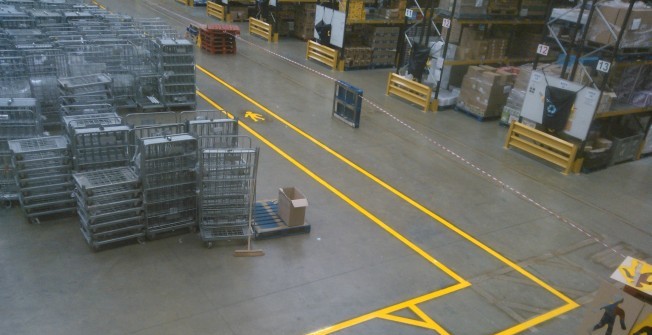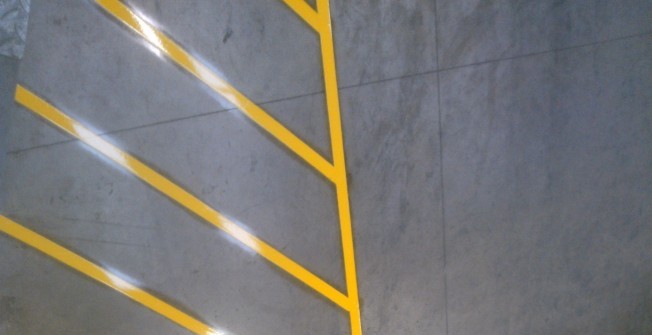We install outdoor surface painting nationwide across the UK.
We install outdoor surface painting nationwide across the UK.



We provide a range of specialist knowledge for warehouse floor markings in Lancashire PR6 8 to ensure the best service for your warehouse markings.
Warehouse floor marking in Lancashire is a crucial aspect of industrial safety and efficiency in the UK, ensuring clear demarcation of areas for traffic operations and pedestrian walkways.
Implementing durable floor markers and tapes is essential to maintain the longevity and effectiveness of these markings, ensuring they can withstand heavy-duty industrial traffic.
Effective colour coding and signage play a vital role in guiding employees and visitors, minimising confusion and enhancing overall safety.
By clearly indicating designated areas for storage, machinery operation, and pedestrian pathways, floor markings help reduce the risk of accidents.
As specialists, we ensure that you are happy and educated on the warehouse surface paint that you are receiving.
The floor paint used in warehouses can be very beneficial as it can benefit the employees for many different reasons. It is very important to ensure you are choosing a good contractor to install the warehouse surface marking as it is possible that the paint could be installed incorrectly.
This is why our specialist team can help you find out more about materials, contractors, installers and providers. We can help with just about anything to do with warehouse surface paint.
For further enquiries or questions, please don't hesitate to contact us via the contact form provided. By doing this, you will be allowing our specialist team to reply to make sure that you are educated on the query you had through the range of expert advice and knowledge offered.
Warehouse floor markings play a crucial role in enhancing safety, efficiency, and organisation within a facility. They help to delineate specific areas, guide traffic, mark storage locations, and highlight safety hazards. Here are the main types of warehouse floor markings:
The average cost of warehouse floor marking is £1,500 - £5,000.
However, several key factors play a significant role in determining the overall cost of warehouse floor marking projects.
It is vital for businesses to explore cost-effective solutions that offer a good balance between durability and affordability.
By choosing high-quality floor marking products that are both long-lasting and reasonably priced, companies can ensure the safety of their employees and assets while staying within budget.
Warehouse floor marking plays a vital role in ensuring safety, enhancing operational efficiency, and promoting organisational clarity in industrial settings.
Clear and well-executed floor markings not only help in preventing workplace accidents but also contribute to the overall smooth running of operations within a warehouse setting.
When walkways, loading zones, storage areas, and other key zones are clearly marked, employees can navigate the space more easily, reducing the risk of collisions and incidents.
These markings aid in maintaining an organised and systematic workplace layout, ensuring that inventory is stored and moved efficiently.
They create a visual guide that directs employees on where items should be placed, picked, and transported, minimising confusion and optimising workflow processes.
By implementing strategic floor markings, companies can establish a structured workspace that not only enhances productivity but also fosters a safe and conducive environment for employees.
It promotes a culture of safety awareness and operational excellence, reflecting the company's commitment to employee well-being and overall efficiency.
Safety is a paramount concern addressed by warehouse floor marking, helping to reduce workplace accidents and ensuring a secure environment for employees in industrial facilities across the UK.
By implementing clear and consistent floor markings, companies are not only demonstrating their commitment to safety but also actively preventing potential risks and hazards.
These visual cues play a crucial role in guiding employees on safe paths, delineating restricted areas, and highlighting emergency exits.
Moreover, warehouse floor marking serves as an essential tool for enhancing emergency preparedness by ensuring swift evacuation routes, facilitating smooth navigation during crises, and aiding emergency responders in locating essential equipment or resources.
Efficiency is a key benefit derived from well-planned warehouse floor marking systems, optimising operational processes and reducing downtime in industrial operations.
Strategic placement of floor markings aids in defining designated pathways for machinery and personnel, facilitating smooth movement and preventing congestion in high-traffic areas.
By delineating specific zones for storage, packing, and shipping, these markings enhance inventory management and ensure accurate stock tracking.
The visual cues provided by floor markings contribute to the clear delineation of workstations and safety zones, promoting seamless operations and minimising accidents.
Employees can easily identify hazardous areas or equipment, thereby reducing the risk of workplace incidents.
Organisational clarity is achieved through effective warehouse floor marking, creating structured pathways for employees, delineating storage areas, and guiding vehicle traffic in industrial environments.
Warehouse floor marking plays a pivotal role in ensuring smooth operations within warehouses and distribution centres.
By strategically using colours, symbols, and signage, workers can easily differentiate between aisles, loading bays, and safety zones.
This not only enhances workplace safety but also aids in preventing accidents and injuries.
Clear and visible markings improve inventory management by providing clear identification of product locations and storage racks. Efficient traffic flow is promoted, reducing bottlenecks and delays.
Effective planning for warehouse floor marking involves identifying key areas, determining necessary markings, and creating a comprehensive floor plan tailored to industrial requirements in the UK.
One of the fundamental steps in initiating a successful floor marking project is conducting a meticulous assessment of the warehouse layout and operations.
By analysing traffic flow patterns, storage zones, and high-risk areas, a clear understanding of where markings are essential can be gained.
This evaluation sets the foundation for selecting the most appropriate types of markings, such as coloured tape, safety signs, or directional symbols, according to established safety guidelines.
Identifying key operational areas is the foundational step in planning warehouse floor marking, enabling targeted solutions for traffic management and pedestrian safety.
High-traffic zones within warehouse facilities are crucial focal points for effective floor marking strategies.
By clearly demarcating these areas using bold coloured lines or signage, you can streamline the flow of goods and personnel, reducing the risk of accidents and bottlenecks.
Marking pedestrian pathways with distinctive symbols or arrows helps ensure the safe movement of employees around the workspace.
By establishing these designated routes, you enhance visibility and mitigate the chances of collision and confusion.
Determining the appropriate types of markings is essential for creating a comprehensive warehouse floor marking system that addresses the specific needs of industrial operations in the UK.
Choosing the right markings involves considering various factors such as visibility, durability, and adherence to regulations.
For traffic control, floor tape or painted lines in bright colours like yellow or red are commonly used to indicate driving lanes, parking areas, and no-entry zones.
Pedestrian guidance markings, on the other hand, may include:
Developing a detailed floor plan is essential for translating marking requirements into a visual layout that optimises safety, efficiency, and compliance in industrial warehouses across the UK.
Creating a comprehensive floor plan involves meticulous attention to detail, ensuring that all necessary markings, directional indicators, and hazard warnings are accurately depicted.
These markings serve as a guiding framework for the seamless flow of operations within the warehouse environment, enabling workers to navigate efficiently and safely.
Clear communication and collaboration among stakeholders play a crucial role in this process, as it ensures that the floor plan aligns with operational workflows and safety protocols.
Regular consultations and feedback sessions help in refining the plan and addressing any potential issues before implementation, fostering a culture of transparency and accountability.
Warehouse floor marking is a systematic approach to using visual cues, colours, and signage to guide employees, vehicles, and pedestrians within industrial premises across the UK.
Warehouse floor marking serves as a blueprint for efficient workflow management, where designated pathways, loading zones, and storage areas are clearly demarcated.
This methodical system not only enhances operational efficiency but also plays a crucial role in mitigating workplace hazards by alerting individuals to potential dangers such as forklift traffic, slippery surfaces, or restricted zones.
By implementing floor markings, companies streamline processes, reduce accidents, and bolster overall productivity through a visual language that fosters order and safety.
Floor markings should be regularly inspected and replaced if they are fading, peeling, or becoming illegible.
The frequency of updating or replacing warehouse floor marking depends on several factors, such as the type of material used, the amount of traffic in the area, and the type of marking.
It is recommended to have a maintenance plan in place to regularly check and replace floor markings as needed.
Warehouse floor marking can be customised to fit the specific needs and layout of a warehouse.
Many companies offer customisable options for colour, size, shape, and symbols or text used in the markings.
This allows for a tailored approach to warehouse floor marking that best suits the organisation's needs and helps improve safety and efficiency.
Our specialist team in Lancashire PR6 8 are always willing to help customers with any enquiries or questions they may have.
By filling out our contact form, the team will respond to your enquiry as soon as possible with the necessary answer to help you find out more about floor painting.